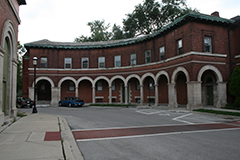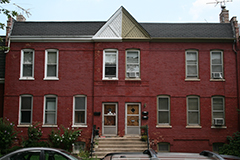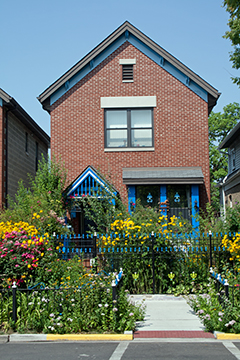-
Membership
Membership
Anyone with an interest in the history of the built environment is welcome to join the Society of Architectural Historians -
Conferences
Conferences
SAH Annual International Conferences bring members together for scholarly exchange and networking -
Publications
Publications
Through print and digital publications, SAH documents the history of the built environment and disseminates scholarship -
Programs
Programs
SAH promotes meaningful engagement with the history of the built environment through its programsMember Programs
-
Jobs & Opportunities
Jobs & Opportunities
SAH provides resources, fellowships, and grants to help further your career and professional life -
Support
Support
We invite you to support the educational mission of SAH by making a gift, becoming a member, or volunteering -
About
About
SAH promotes the study, interpretation, and conservation of the built environment worldwide for the benefit of all
Chicago's Pullman Neighborhood
This summer, SAH had two interns from the University of Chicago, Hannah Loftus and Kevin Robinson, who worked on SAHARA. Hannah and Kevin uploaded more than 900 images to SAHARA and worked on individual research projects documenting new Chicago parks and vernacular Chicago architecture, respectively. Read about Kevin's research below:
Chicago’s Pullman neighborhood raises many of the issues frequently associated with contemporary urban living: gentrification, economic inequality, and preservation to name a few. The community, established in 1880 to house workers of the Pullman Company, is about twelve miles south of downtown Chicago. The residential area is roughly bounded by 111th and 115th streets at the north and south, and by railroad tracks and Cottage Grove Avenue at the east and west. The actual Pullman factory is directly north of this area. The town was the brainchild of George Pullman and architect Solon Spencer Beman. Beman’s design for Pullman fits into no discrete architectural style but creates a distinct visual identity for the town. Above all he sought “to design attractive and functional buildings,” resulting in a jumble of architectural-historical references.[1] There are clear American Queen Anne influences in many of the larger homes, while Rees points out Gothic details in the Hotel Florence, which is one of the most striking buildings in the neighborhood. The hotel, which sits on Arcade Park and is named after Pullman’s daughter, was off-limits to workers, as it was the one exception to the town’s ban on the sale of alcohol. Despite the lack of stylistic uniformity in Pullman, Berman created visual unity by using brick made of clay dredged from Lake Calumet, adjacent to the town. This unity is preserved in large part today as there are few recently-constructed buildings. A significant portion of the original late-nineteenth century buildings still stand today. What particularly interested me about Pullman was how, if at all, its architecture dating back 130 years structures the present community.
 Arriving to the neighborhood by train I was reminded of a phrase coined by a Russian author, Yury Olesha, who referred to artists as ‘engineers of the human soul.’ Although it might have been the industrial landscape that reminded me of engineering, I think that the expression came to mind because, bluntly put, the planned community seemed somewhat soulless. Despite the fact that the buildings all looked occupied, the streets were empty and none of the civic buildings seemed to be open on a weekday afternoon. The well-used recreational areas are at the peripheries of the neighborhood, while the more central town square and Arcade Park are empty and uninviting. At first I suspected that the buildings and spaces themselves fostered this disconnect: they seem to insist that they are at once historical and new. They want to remain connected to the good old days, but are also retrofitted for modern living. The ‘for sale’ signs that dot the streets signal new bricks and windows that replicate and replace the old. Pullman’s renovators and real estate agents seem to say that the past can be easily substituted with something that looks just like it, and more importantly that it can still be sold as ‘historic.’
Arriving to the neighborhood by train I was reminded of a phrase coined by a Russian author, Yury Olesha, who referred to artists as ‘engineers of the human soul.’ Although it might have been the industrial landscape that reminded me of engineering, I think that the expression came to mind because, bluntly put, the planned community seemed somewhat soulless. Despite the fact that the buildings all looked occupied, the streets were empty and none of the civic buildings seemed to be open on a weekday afternoon. The well-used recreational areas are at the peripheries of the neighborhood, while the more central town square and Arcade Park are empty and uninviting. At first I suspected that the buildings and spaces themselves fostered this disconnect: they seem to insist that they are at once historical and new. They want to remain connected to the good old days, but are also retrofitted for modern living. The ‘for sale’ signs that dot the streets signal new bricks and windows that replicate and replace the old. Pullman’s renovators and real estate agents seem to say that the past can be easily substituted with something that looks just like it, and more importantly that it can still be sold as ‘historic.’
 After some consideration I realized that even if I were to see Pullman in the 1880s that I would likely find the experience just as unsettling as I find it presently. I think on the one hand this is because Pullman is geographically sectioned off from surrounding areas by railroad tracks and Lake Calumet. These barriers are not only physical but gave me a definite psychological impression of the neighborhood as somehow existing in a vacuum or a museum display case. On the other hand, Pullman was a curated residential experience: its communal spaces were created for an imagined community rather than one that had already formed beyond the fact that it was meant for workers of one company. Amanda Rees notes that “Pullman’s singular innovation was the application of aesthetics, however, the visual ideology of the communities were not merely there to produce productive workers... it is clear that the Pullman community was to be a central element of the company brand.”[2] Like advertising that tries to make us aware of a need that we may not have, George Pullman and the town’s architect Solon Spencer Beman not only found the idea of community necessary but something that could be enforced and controlled through designed space. That is not to say that community is a bad thing, but that this community was meant to be George Pullman’s, not the residents’. As a result, many aspects of the residents’ collective identity were given to them ready-made, denying them significant power to form a community that truly reflected them.
After some consideration I realized that even if I were to see Pullman in the 1880s that I would likely find the experience just as unsettling as I find it presently. I think on the one hand this is because Pullman is geographically sectioned off from surrounding areas by railroad tracks and Lake Calumet. These barriers are not only physical but gave me a definite psychological impression of the neighborhood as somehow existing in a vacuum or a museum display case. On the other hand, Pullman was a curated residential experience: its communal spaces were created for an imagined community rather than one that had already formed beyond the fact that it was meant for workers of one company. Amanda Rees notes that “Pullman’s singular innovation was the application of aesthetics, however, the visual ideology of the communities were not merely there to produce productive workers... it is clear that the Pullman community was to be a central element of the company brand.”[2] Like advertising that tries to make us aware of a need that we may not have, George Pullman and the town’s architect Solon Spencer Beman not only found the idea of community necessary but something that could be enforced and controlled through designed space. That is not to say that community is a bad thing, but that this community was meant to be George Pullman’s, not the residents’. As a result, many aspects of the residents’ collective identity were given to them ready-made, denying them significant power to form a community that truly reflected them.
On the one hand, there is no one way to use a home or neighborhood. The simple fact of living in Pullman does not require one to use the spaces in a particular way. George Pullman could only expect the residents of his town to use the town square; it would be much more difficult to force them to actually use it. On the other hand, living in Pullman does bring certain limitations. Some, such as its distance from downtown, cannot be changed while others, such as the stigma of being on the South Side, are socially mediated. I believe that this tension between what can and cannot be planned prohibits one person or one vision from completely structuring a community. Inevitably some aspect of the community must be planned. There is, however, always room for residents of a neighborhood to build a community ‘of the people,’ though how much room they have varies by place and time.
 My reaction to Pullman forced me to look back on a previous trip to Chicago’s Wicker Park neighborhood in a new light. There I noticed rehabbed nineteenth century worker’s cottages alongside post-modern homes that borrowed from the neighborhood vernacular style generously. A notable example of the latter is 1336 North Leavitt Street (ca. 1998-2002), which copies the basic size and shape of neighboring homes but adds a bright blue trim. I wonder what motivated the architect or owner to design the house this way at all, whether it was out of a notional deference to the vernacular or if this quasi-historicism simply sells better. Certainly this home in particular is not one of the most attractive in the neighborhood—for example, the brick noticeably differs in appearance and quality compared to its older counterparts—but it raises questions about the identities of neighborhoods. In contrast to Pullman, Wicker Park has many modern homes that pay no deference to the ‘look’ of the neighborhood. The architect or homeowner’s stamp on the neighborhood seems much more forceful here. Obviously one modern home in Wicker Park cannot completely change its character, but I also cannot tell how much these homes exist in relation to the rest of the neighborhood. Is their purpose defeated when they no longer stand out, or are they conceived as monoliths? The modernist ‘make it new’ mentality is not only disconcerting here but somehow feels belated, as if we never stopped to think about what impact ‘new’ can have. Despite whatever misgivings I have about 1336 Leavitt, I know that it at least plays with and very intentionally departs from the neighborhood style. In a way, this home is less troubling than some of the more attractive and interesting modern homes. It doesn’t quite let us forget about the past, but it also lets us know that we can’t rely on it to understand the past.
My reaction to Pullman forced me to look back on a previous trip to Chicago’s Wicker Park neighborhood in a new light. There I noticed rehabbed nineteenth century worker’s cottages alongside post-modern homes that borrowed from the neighborhood vernacular style generously. A notable example of the latter is 1336 North Leavitt Street (ca. 1998-2002), which copies the basic size and shape of neighboring homes but adds a bright blue trim. I wonder what motivated the architect or owner to design the house this way at all, whether it was out of a notional deference to the vernacular or if this quasi-historicism simply sells better. Certainly this home in particular is not one of the most attractive in the neighborhood—for example, the brick noticeably differs in appearance and quality compared to its older counterparts—but it raises questions about the identities of neighborhoods. In contrast to Pullman, Wicker Park has many modern homes that pay no deference to the ‘look’ of the neighborhood. The architect or homeowner’s stamp on the neighborhood seems much more forceful here. Obviously one modern home in Wicker Park cannot completely change its character, but I also cannot tell how much these homes exist in relation to the rest of the neighborhood. Is their purpose defeated when they no longer stand out, or are they conceived as monoliths? The modernist ‘make it new’ mentality is not only disconcerting here but somehow feels belated, as if we never stopped to think about what impact ‘new’ can have. Despite whatever misgivings I have about 1336 Leavitt, I know that it at least plays with and very intentionally departs from the neighborhood style. In a way, this home is less troubling than some of the more attractive and interesting modern homes. It doesn’t quite let us forget about the past, but it also lets us know that we can’t rely on it to understand the past.
I wonder if some of Pullman’s residents ever stop to ask why they’re remodeling their 1880s homes. Do they want to replicate the original kitchen surfaces or do they install granite countertops? It seems to me that Pullman can go one of two directions. The first is the one we see most frequently with gentrifying neighborhoods, with a desire for new ‘modern-looking’ homes and rehabilitated ‘historic’ homes. This would make Pullman visually similar to Wicker Park. The second direction is one in which the residents don’t commit to either idea but play with them both (think Norman Foster’s Reichstag restoration). This play can be somewhat muddled, as with 1337 Leavitt, or it can give the residents room to deliberately and clearly articulate their own views on Pullman’s preservation, past, and future.
Looking back on my visit, I felt that the model town begged to remind me of something. I think it asks us to remember both that it is there and that it has an important history. Certainly this history can inform how we preserve, restore, and develop Pullman as well as other neighborhoods. In the end, however, this plea to remember fell flat with me because it was so difficult to connect with the buildings. I wonder if this feeling fosters a sense of privacy that the residents enjoy. With the voices of Pullman and Beman drowned out by time, I believe that in time the residents can and will surprise us with their own solutions.
About Kevin:
Kevin Robinson is a 2012 Jeff Metcalf Fellow at the Society of Architectural Historians and a fourth-year undergraduate at the University of Chicago studying art history. He recently completed research on Kazimir Malevich’s painting techniques and is currently studying the sculpture of Anthony Caro. In his free time he pursues interests in Russian literature, competitive napping, and aviation.
Resources:
Crawford, M., 1991. Designing the company town 1910-1930. Thesis (PhD). University of
California, Los Angeles.
Crawford, M., 1995. Building the workingman’s paradise: the design of American company towns. New
York: Verso.
Buder, S., 1967. Pullman: an experiment in industrial order and community planning 1880-1930. New York: Oxford University Press.



Leave a commentOrder by
Newest on top Oldest on top